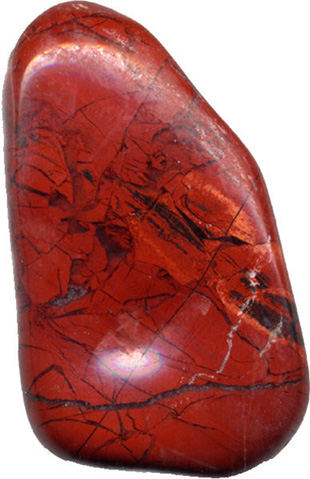












This mineral breaks with a smooth surface, and is used for ornamentation or as a gemstone. It can be highly polished and is used for vases, seals, and at one time for snuff boxes. When the colors are in stripes or bands, it is called striped or banded jasper. Jaspilite is a banded iron formation rock that often has distinctive bands of jasper.
Etymology and historical/mythical usage
The name means "spotted stone", and is derived from Anglo-French jaspre, from Old French jaspe, from Latin iaspidem, the accusative of iaspis, from Greek iaspis, via a Semitic language (cf. Hebrew yashepheh, Akkadian yashupu), ultimately from Persian yashp.
The word yashepheh in the Masoretic text of Exodus 28:20, referring to a stone in the Hoshen, is thus reflected in the Septuagint by the word Iaspis, and usually translated into English as Jasper. Despite the most common form of Jasper being red, scholars think that the yashepheh here actually refers to a green form of Jasper - which was very rare, and so highly prized; the Greeks used Iaspis to refer to the green form, while the red form simply fell under the term Sard - which just means red. Rebbenu Bachya argues that this stone represents the tribe of Benjamin, but there is actually a wide range of views among traditional sources about which tribe the stone refers to.
It is described in the Book of Revelation (21:11) as follows: "It shone with the glory of God, and its brilliance was like that of a very precious jewel, like a jasper, clear as crystal."
Alternative beliefs
In the traditions of some American Indian tribes, jasper can help bring rain. In several cultures it is credited with driving away evil, especially spirits or venomous creatures. Crystal users believe it brings calmness, clarity of thought, and mental balance.
Traditional healers consider jasper a "general" healing stone, as well as strengthening the stomach and helping with feminine problems. It is said to help "lower chakras".
Types of jasper
Jasper can appear as an opaque rock of shades of red due to mineral impurities. Patterns can arise from the formation process and from flow patterns in the sediment or volcanic ash that was saturated with silica to form jasper, yielding bands or swirls in the rock.
Jasper may be permeated by dendritic minerals providing the appearance of vegetative growths. The jasper may have been fractured and/or distorted after formation, later rebonding into discontinuous patterns or filling with another material. Heat or environmental factors may have created surface rinds (such as varnish) or interior stresses leading to fracturing.
Egyptian jasper is a brown jasper, appearing as nodules in the Libyan desert and in the Nile valley between the Red Sea and Cairo, Egypt, distinguished by a zonal order of light and dark shades of colors. Egyptian jasper is also known as Egyptian pebble.
Picture jaspers simultaneously exhibit several of these variations (such as banding, flow patterns, dendrites or color variations) resulting in what appear to be scenes or images in a cut section (as in Biggs, Deschutes, Owyhee, Poppy and other named types). Spherical flow patterns produce a distinctive orbicular appearance (porcelain jaspers such as Blue Mountain, Bruneau and Willow Creek). Complex mixes of impurities produce wild color variations (as in McDermitt jasper). Healed fractures produce brecciated jasper (such as Canyon Creek). Examples of this can be seen at Llanddwyn Island.
Jasper is the gemstone of the Rooster from the Chinese Zodiac.
Paris Ceramics use red jasper in many of their Pietre Dure and Inlay creations. This can take many forms from Pietre Dure Tabletops (click here for product example) right through to delicately Inlaid floors
By Appointment
PARIS CERAMICS
South Park Studios - Suite 10
88 Peterborough Road, London SW6 3HH
United Kingdom